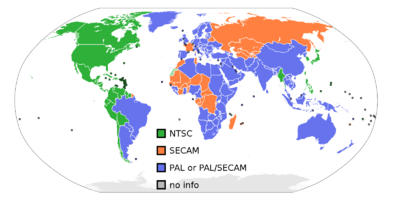NTSC: Difference between revisions
No edit summary |
(Still needs work, but there's some sort of structure to it now.) |
||
| Line 1: | Line 1: | ||
{{cleanup|Put info here that is relevant only to NTSC, and expand on this article even more. Check the version differences and add to this article.}} | {{cleanup|Put info here that is relevant only to NTSC, and expand on this article even more. Check the version differences and add to this article.}} | ||
[[ | [[File:PAL-NTSC-SECAM.png|thumb|400px]] | ||
'''NTSC''' | '''NTSC''' was an analogue television encoding used primarily in North America and Japan. While it has been made obsolete by the use of digital component encoding, the term survives as a colloquial reference to the version of games and other televisual media released in the former NTSC regions. | ||
==Regional differences== | |||
===Regional variations=== | |||
{{main|List of regional version differences (SSBM)|List of regional version differences (SSBB)}} | |||
Most of the differences between the NTSC and PAL versions of the ''Super Smash Bros.'' games are related to the later release of the latter, allowing for bugs to be patched and other changes to be made. Some of these changes include: | |||
*Peach's dash attack is more powerful in the NTSC versions of the game | *Peach's dash attack is more powerful in the NTSC versions of the game | ||
*The Home Run Contest Platform is larger than in other versions. | *The Home Run Contest Platform is larger than in other versions. | ||
===Region coding=== | |||
In an attempt to maintain the integrity of release dates that differ between continents, most DVDs and video games have region specific codes that allow them to only be played on consoles made in certain regions. ''[[Super Smash Bros. Melee]]'' and ''[[Super Smash Bros. Brawl]]'', like all [[Nintendo GameCube]] and [[Wii]] games, are region specific. | |||
== See Also == | == See Also == | ||
* [[PAL]] | * [[PAL]] | ||
* [[ | * [[Wikipedia:NTSC|Wikipedia's NTSC article]] | ||
{{stub}} | {{stub}} | ||
[[Category:Game regions]] | |||
Revision as of 13:42, December 24, 2010
NTSC was an analogue television encoding used primarily in North America and Japan. While it has been made obsolete by the use of digital component encoding, the term survives as a colloquial reference to the version of games and other televisual media released in the former NTSC regions.
Regional differences
Regional variations
Most of the differences between the NTSC and PAL versions of the Super Smash Bros. games are related to the later release of the latter, allowing for bugs to be patched and other changes to be made. Some of these changes include:
- Peach's dash attack is more powerful in the NTSC versions of the game
- The Home Run Contest Platform is larger than in other versions.
Region coding
In an attempt to maintain the integrity of release dates that differ between continents, most DVDs and video games have region specific codes that allow them to only be played on consoles made in certain regions. Super Smash Bros. Melee and Super Smash Bros. Brawl, like all Nintendo GameCube and Wii games, are region specific.
See Also


